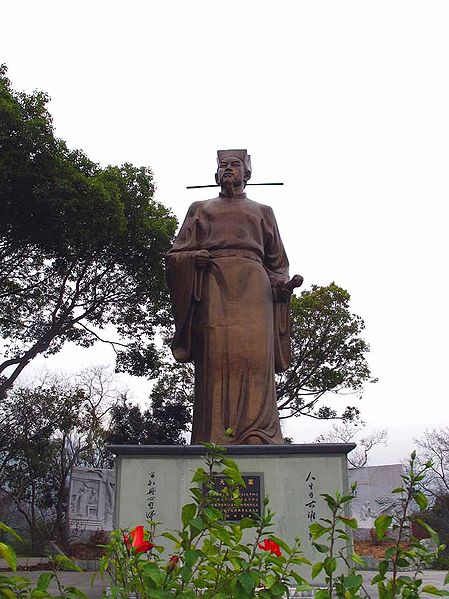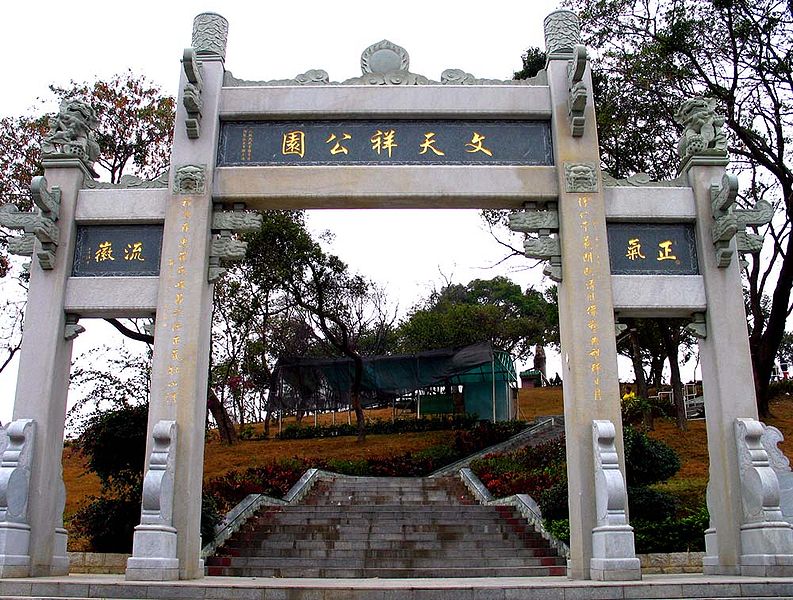<Back to Index>
- Mathematician Aleksandr Mikhailovich Lyapunov, 1857
- Dramatist Pierre Corneille, 1606
- Duke of Xinguo Wen Tianxiang, 1236
PAGE SPONSOR

Wen Tianxiang (Chinese: 文天祥; pinyin: Wén Tiānxiáng; Cantonese Yale: Man Tin Cheung; June 6, 1236 – January 9, 1283 AD), Duke of Xinguo, was a scholar-general in the last years of the Southern Song Dynasty. For his resistance to Kublai Khan's invasion of the Song, and for his refusal to yield to the Yuan Dynasty despite being captured and tortured, he is a popular symbol of patriotism and righteousness in China. He is considered one of three heroes of the Song's last years, alongside Lu Xiufu and Zhang Shijie.
His symbolic role can be seen from the following fact of 1908: in Wen Tianxiang's historical shrine in Haifeng, Chen Jiongming persuaded over thirty young men of the village to swear secret support for a
national revolution. (Leslie H. Dingyan Chen, Chen Jiongming and the
Federalist Movement: Regional Leadership and Nation Building in Early
Republican China). Wen was born on 6 June 1236 in Luling (Ji'an), Jiangxi Province during
the Song Dynasty. At the age of 18 he excelled in his local
examinations, and two years later participated in examinations in the
capital, during which he was personally awarded first rank by the
emperor. He would subsequently take up several posts in the government
of the Southern Song, including being Attendant (郎官) of the Justice
Ministry and Prefect of Ganzhou. In 1278, Wen was captured by the invading Yuan armies of Kublai Khan,
"offered" a Yuan post, and ordered to convince the remaining Song
forces to surrender. Wen refused both and suffered for 4 years in a
military prison before his execution in 1283. During this time he wrote
the famous classics "Song of Righteousness" (Zhengqige), and "Passing Lingdingyang". Wen Tianxiang adopted the three sons of his younger brother when his two sons died young. Legend has the Wen family name existing during the western Zhou Dynasty over 3,000 years ago. Historical lineages can be documented to 1,500 years ago to Sichuan province. There are now at least six branches of the Wen family in the provinces of Jiangxi, Hunan, Hainan, Guangdong, Fujian, and Hong Kong with some overseas. Local dialect pronunciations would be Man (Cantonese), Vun (Hakka), and Bun (Hokkien). The Man clan are considered one of the original founding families in the history of Hong Kong. The well-known Ming dynasty painter and calligrapher Wen Zhengming also belonged to the Wen family. The mother of Mao Zedong, Wen Qimei, was a descendant as well. The majority of Wen Tianxiang's descendants still live in mainland China. One of the oldest continuous branches of the Wen family established itself in the Hengyang/Hengshan area of present-day Hunan shortly
after AD 1000. A branch of this Wen family settled in the United States
in the mid 1940s and is related through marriage to the prominent Sun
family of Shouxian, Anhui (Sun Jianai; Fou Foong Flour Company 福豐麵粉廠) and the Li family of Hefei, Anhui (Li Hongzhang 李鴻章).
Wen Tianxiang's hometown in Ji'an, Jiangxi honors
the famous national hero with a mausoleum. Exhibitions of paintings,
calligraphy, and even army uniforms supposedly left by Wen are
displayed in the Wen Family Ancestral Temple in Futian. The Wen Tianxiang Mausoleum is located in Wohushan. The
Memorial to Prime Minister Wen Tianxiang was built in 1376 during the
reign of the Ming Emperor Hongwu. The location of Wen's execution is
thought to be near the entrance to Fuxue Alley in the East City
District of Beijing and a memorial has been established on the northern
side of the entrance to South Fuxue Alley near Beixinqiao. "The
Song Dynasty's Top Ranking Scholar and Prime Minister, the West River's
Filial Son and Loyal Subject," is carved into the columns of the
memorial's main hall. The San Tin village in the New Territories of Hong Kong, is home to many villagers surnamed "Man" in Cantonese. The "Man" villagers trace their ancestry to Man Tin Cheung via Man Tin-Sui, also a famous Song Dynasty general and the cousin of Man Tin Cheung. A
Man Tin Cheung Memorial Park and "Man" ancestral hall and residences
(Tai Fu Tai) in San Tin is a popular historical attraction in Hong Kong.
